Length about 20km Country New Zealand | Source Kaikoura Ranges | |
 | ||
Main source Seaward Kaikoura Range
highest tributaries rise at about 2,000m River mouth South Pacific Ocean
sea level | ||
Hapuku river dam monitoring kaikoura earthquake harvest electronics
The Hapuku River is a river of New Zealand. It begins in the Seaward Kaikoura Range and flows south-east to enter the South Pacific at Hapuka, between Clarence and Kaikoura. The name comes from the Māori word Hapuku or Hapuka, a deep-water marine fish.
Contents
The main tributary is the Puhi Puhi River.
The Hapuku is bridged by a 1,500 ft (460 m), 1940 bridge on 23 spans of 67 ft (20 m) on the Main North Line and by an 11 span, 227 m (745 ft) long, 8.6 m (28 ft) wide, 1983 SH1 bridge. The first bridge was completed in 1915, with foundations over 26 ft (7.9 m) deep, though the approaches were a little later.
Whilst other rivers were affected by serious flooding in 1953, the Hapuku rose only 6.5 ft (2.0 m) at the railway bridge. Presumably this was due to the short catchment, the tectonic uplift of its headwaters and the width of the braided river bed, which is a source of railway ballast. However, a 1868 flood had more of an impact upstream, leaving a 30 ft (9.1 m) bank and a 1941 flood damaged the railway.
Wildlife associated with the area include black-eyed geckos, found near the headwaters of the north branch Hapuku River, and bluff wetas. Banded dotterels breed in the Hapuku.
Introduced species include red deer, goats (kept at low levels by culling), pigs and chamois.
There were two DoC huts in the valley; Hapuku Hut and Barratts Bivvy, linked by walking tracks. However, a slip triggered by the 2016 Kaikoura earthquake blocked the river, with water building up behind the slip and destroying Barratts Hut and Bivvy.
Hapuka railway station was open from 13 March 1944 until 29 March 1981, though a passing loop and ballast siding remain.
